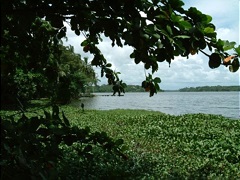 |
Home About Directory Conservation |
 |
Bolgoda Wetlands Location: 60 50’ 0 N and 790 52’ 0 E to 60 38’ 0 N and 800 0’ 0 E; 755472 N and 374770 E to 733327 N and 389460 E; 30 km south of Colombo in the Kalutara District, of the Western Province. Area: The Kalu and Kelani river basins including the Bolgoda River cover an area of 1,245 ha. The extent of the marshes is unknown. Altitude: Near Sea level Overview: The Bolgoda Lake is a shallow brackish water body in the Bolgoda watershed that is located between the southern border of the Kalu Ganga basin and the northern border of the Kelani river basin in the wet zone of the country. It is categorised as a semi-closed lagoon, as it is not connected to the sea throughout the year. Physical features: This lake system drains a substantial area (374 km2) wedged between the western parts of the Kalu and Kelani river basins. It is made up of two basins namely the north lake and the south lake, which are connected by a narrow stream. The north lake, a part of which belongs to the Colombo and Kalutara Districts is the larger one. It is fed by Weras Ganga and Bolgoda Ganga, which bring water from the South Lake. It discharges to the sea through the Panadura estuary. The South Lake is situated in the Kalutara District and is fed by Panape Ela. It is connected to the sea via Thalpitiya Ela. Bolgoda Ganga, the canal that connects these two water bodies is joined by Rambana Ela, which drains the water of the Maha Oya into the lake system. This shallow dual basin estuary is mainly fed by monsoonal rain in addition to minor inflows, which are exclusively confined to the first peneplain in the wet zone. It receives an annual rainfall of about 2,569.3 mm and the mean annual temperature is 27.1o C. The substratum of the Bolgoda Lake comprises of a high percentage of clay and silt. Depth varies from a few centimetres to more than 2m, but a large area of the lake is situated between the 1m and 2m isobaths. The tidal amplitude of the Lake varies between 1 cm and 75 cm. Ecological features: The lake and marshes are surrounded by scrubland, coconut cultivations, home gardens and an urban landscape. The vertebrate fauna recorded in the Bolgoda south lake include 45 fish, 16 amphibian, 40 reptile, 97 bird and 31 mammal species. Noteworthy fauna: These wetlands support a number of endemic fauna including fish (Esomus thermoicos, Channa orientalis, Clarias brachysoma, Aplocheilus dayi); reptiles (Otocryptis weigmanni, Cylindrophis maculatus, Lycodon osmanhilli, Oligodon sublineatus, Xenocrophis asperrimus); birds (Loriculus beryllinus, Megalaima flavifrons, Pellorneum fuscocapillum); mammals (Trachypithecus vetulus) and amphibians (Bufo atukoralei,Rana gracilis, Polypedatus cruciger). Additionally, these wetlands are known to harbour rare species such as Loris tardigradus, Pelecanus philippensis, Prionailurus viverrinus, Lutra lutra and Crocodylus palustris. The commercially valuable, but invasive Oreochromis mossambicus is also found in these waterways. Noteworthy flora: The marshy areas harbour species such as Sonneratia caseolaris, Nypa fruticans, Syzygium spp., and Acrostichum aureum. Land use: The natural vegetation within the 6,000 ha watershed has been substituted by two major crops (paddy and rubber) and village gardens. Several densely populated townships are located along the coastal boundary of the watershed; as such, the entire watershed is subjected to infrastructure development. Additionally, this wetland supports local fisheries. Possible changes in land use: Increased clearing of land for infrastructure development due to growing population pressures in the surrounding areas and due to its popularity as a holiday-home destination. Hydrological and biophysical values: The lake water is being used to irrigate the paddy fields in the surrounding area. Additionally, the local communities use it for several domestic purposes. Social and cultural values: As this site is located close to the city of Colombo, it serves as a popular holiday destination for families, many of whom own their own homes. Additionally, it is easily accessible to bird-watchers. Scientific research and monitoring: NARA has conducted some comprehensive water quality studies on this wetland in the past. The YZA conducted the last comprehensive study on biodiversity of this area in1995. Conservation education: Information not available Recreation and tourism: This area attracts avid bird-watchers and holiday-home owners due to its proximity to the city. Conservation measures taken: This site was declared a FMA by the DFAR in 2001. Conservation measures proposed: The Bolgoda Lake is a proposed EPA under the NEA of the CEA. Other conservation measures have been proposed in Silva (1996). Disturbance and threats: The release of industrial effluents from textile factories and printers located in the surrounding areas into the Weras Ganga. Eutrophication caused by pesticides and fertilisers used in agriculture and domestic waste also contaminate the lake. As the major east-west shipping routes lie along the southern coast, maritime waste may also enter the lake via the Panadura estuary. Other issues such as intense recreational activities and improper land use in the upper watershed, land reclamation and mangrove deforestation are on the increase. In addition, invasive alien species such as Typha angustifolia, Eichhornia crassipes, Annona glabra and Chitala ornata pose problems to the native biodiversity. Need urgent actions to mitigate existing threats. Land tenure: State owned but surrounded by private lands. Management authority and jurisdication: DFAR manages the fisheries References: Ranwella (1995); Silva (1996) |
| Maps |